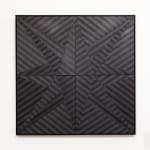James Little USA, b. 1952
Fat Star, 2022
Oil and wax on linen
72 x 72 in
182.9 x 182.9 cm
182.9 x 182.9 cm
8616
Further images
-
(View a larger image of thumbnail 1
)

-
(View a larger image of thumbnail 2
)

-
(View a larger image of thumbnail 3
)

-
(View a larger image of thumbnail 4
)

-
(View a larger image of thumbnail 5
)

-
(View a larger image of thumbnail 6
)

-
(View a larger image of thumbnail 7
)

-
(View a larger image of thumbnail 8
)

-
(View a larger image of thumbnail 9
)

-
(View a larger image of thumbnail 10
)

This painting was created for Black Stars & White Paintings, the highly anticipated solo exhibition at Kavi Gupta gallery in Chicago of new paintings by New York-based abstract artist James...
This painting was created for Black Stars & White Paintings, the highly anticipated solo exhibition at Kavi Gupta gallery in Chicago of new paintings by New York-based abstract artist James Little, a critically and publicly celebrated highlight of the 2022 Whitney Biennial, Quiet as It's Kept. Little’s erudite Black Stars captivate the eye with their velvety luster, dramatic, acuminate forms, and restrained palette of only two shades of black. Their elegant simplicity belies the months of exacting effort Little invests building up their luxuriant surfaces with dozens of layers of handmade encaustic paints—a medium he painstakingly manufactures himself in his Brooklyn studio. Reflective of Little’s lifelong study of color relationships and formal aesthetic theories, these guileless masterworks demand veneration as monuments to pure abstraction. Yet, as their carefully crafted name reveals, they simultaneously proclaim Little’s grasp of this historical moment, and his awareness of how identity politics has often skewed people’s perspective on his work. “I call them Black Stars because they are black stars,” Little says. “The name Black Stars is also a reflection on Black exceptionalism. It’s a celebration of that. But that’s not what drove me to make the paintings. That whole racial aspect isn’t any more important to me than trying to paint some emblematic arrangements with two tones of black.”









